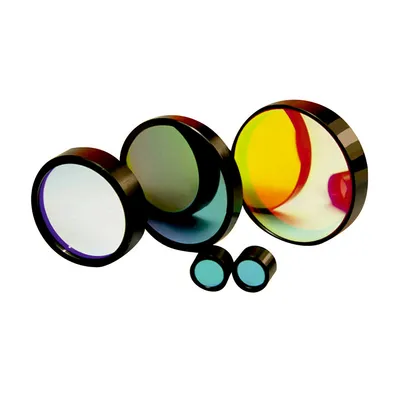Optical Filters
Optical filters are critical components in photonic systems, designed to selectively transmit or block specific wavelengths of light for enhanced system performance. They are widely used in applications like biomedical imaging, spectroscopy, and telecommunications, where precise wavelength control is essential. At Firebird Optics, we specialize in custom optical filters tailored to meet your unique requirements. Whether you need bandpass, longpass, shortpass, or neutral density filters, our advanced coating technologies and expertise ensure exceptional spectral performance, durability, and reliability for demanding applications.
Shortpass Filters
Shortpass Filters
Firebird Optics Shortpass Filters are expertly crafted using durable hard dielectric coatings, designed to precisely isolate specific regions of the spectrum. These advanced coatings ensure high optical performance, providing excellent transmission in the passband while effectively blocking unwanted wavelengths in the stopband. The precision of these filters makes them ideal for applications requiring strict wavelength control, such as spectroscopy, imaging, and laser systems.
Unlike traditional colored glass filters, Firebird Optics Shortpass Filters offer a sharp step cut-off or transition between the passband and stopband. This distinct feature enhances their efficiency and versatility, making them a superior choice for modern optical systems. Whether for scientific research or industrial applications, these filters deliver reliable performance and durability under demanding conditions.
Features:
Made from optical quality Schott glass
UV or VIS bandpass applications possible
Comes in a variety of sizes and shapes including circular and rectangular from .Ø25 mm up to 152.4mm.
Understanding Shortpass Filters: Key Components for Optical Systems
Shortpass filters are critical optical components designed to transmit wavelengths below a specific cutoff point while reflecting or blocking longer wavelengths. For example, they are widely used in fluorescence microscopy to isolate excitation light from emitted light, ensuring high-contrast imaging. These filters are widely used in applications such as fluorescence microscopy, spectroscopy, machine vision, and laser systems. Their ability to selectively manage light makes them indispensable in precision optical setups.
This article explores the features, types, applications, and advantages of shortpass filters, shedding light on their role in advancing modern optical technologies.
What Are Shortpass Filters?
Shortpass filters, also known as low-pass filters, are optical devices that allow shorter wavelengths to pass through while reflecting or blocking longer wavelengths. Constructed using dielectric coatings, these filters offer sharp cutoff points, high transmission, and excellent durability. Their performance is characterized by:
Cutoff Wavelength: The wavelength at which the filter transitions from transmission to reflection. This is determined by the specific design and material properties of the filter, ensuring precision for applications like fluorescence microscopy or spectroscopy, where accurate wavelength separation is critical.
High Transmission Efficiency: Ensuring minimal signal loss for transmitted wavelengths.
Durable Coatings: Providing resistance to environmental factors and ensuring long-term reliability.
Shortpass filters are typically designed for use at specific angles of incidence, ensuring optimal performance in various optical systems.
Types of Shortpass Filters
Edge Filters
Edge filters are the most common type of shortpass filters. For instance, they are frequently used in fluorescence imaging to isolate specific wavelengths required for accurate biological analysis. These filters feature a well-defined cutoff wavelength, making them ideal for separating spectral bands in applications such as fluorescence imaging and spectroscopy. Edge filters are the most common type of shortpass filters. They feature a well-defined cutoff wavelength, making them ideal for separating spectral bands in applications such as fluorescence imaging and spectroscopy.
2. Notch Filters
While primarily designed for band rejection, some notch filters incorporate shortpass characteristics to block specific longer wavelengths while allowing shorter wavelengths to pass.
3. Custom Shortpass Filters
For specialized applications, custom shortpass filters can be designed with tailored cutoff wavelengths, transmission ranges, and physical dimensions to meet specific requirements.
Applications of Shortpass Filters
1. Fluorescence Microscopy
In fluorescence microscopy, shortpass filters are used to isolate excitation light from emitted fluorescence. This ensures clear imaging and accurate analysis in biological and medical research.
2. Spectroscopy
Shortpass filters play a crucial role in spectroscopy by selectively transmitting desired wavelengths for analysis while blocking unwanted light. This enhances measurement accuracy and improves signal-to-noise ratios.
3. Machine Vision
Machine vision systems utilize shortpass filters to improve image contrast by blocking ambient light and allowing specific wavelengths to pass. This is essential for applications like quality control, barcode scanning, and object detection.
4. Laser Systems
Shortpass filters are employed in laser systems to manage beam paths and enhance system performance. They ensure precise wavelength control in applications like laser marking, cutting, and alignment.
Environmental Monitoring
In environmental monitoring, shortpass filters are used to analyze specific wavelengths of light reflected from the Earth’s surface, aiding in applications such as studying vegetation health, monitoring water quality, and assessing atmospheric conditions. For instance, they can help detect changes in chlorophyll absorption in plants or identify pollutants in water bodies, providing critical insights for ecological conservation and resource management. In environmental monitoring, shortpass filters are used to analyze specific wavelengths of light reflected from the Earth’s surface, aiding in the study of vegetation, water quality, and atmospheric conditions.
6. Photography and Imaging
Shortpass filters are incorporated into cameras to block infrared light, ensuring better color reproduction and image clarity in photography and high-speed imaging.
Advantages of Shortpass Filters
High Precision: Shortpass filters provide precise wavelength separation, critical for high-resolution applications.
Durability: Constructed with robust dielectric coatings, these filters resist scratches, environmental damage, and thermal stress.
Low Insertion Loss: High transmission efficiency ensures minimal loss of signal strength, preserving optical system performance.
Versatility: Available in a wide range of sizes, materials, and configurations to suit diverse applications.
Customization: Easily tailored to specific requirements, enabling optimal integration into specialized optical systems.
Key Considerations for Selecting Shortpass Filters
Wavelength Requirements: Identify the cutoff wavelength needed for your application.
Angle of Incidence: Ensure the filter is designed for the operating angle of your optical system.
Coating Durability: Consider the environmental conditions and ensure the coating can withstand them.
Transmission Efficiency: Evaluate the percentage of light transmission in the passband to meet system requirements.
Physical Dimensions: Ensure the filter’s size and shape align with your system design.







